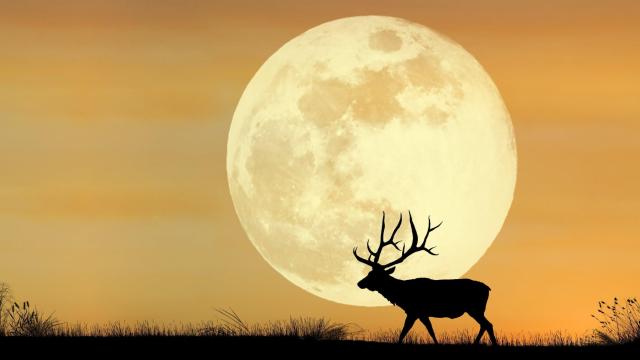Look to the sky on October 21 for a view of the Hunter’s Moon in its full glory. The moon will be nearly 100 per cent full on these days, and will project some beautifully reflected sunlight all over the earth…barring a cloudy night, of course.
When is the Hunter’s Moon?
The moment of brightest illumination for the hunter’s moon is at 12:26 A.M. AEDT on Thursday, October 21. Of course, you won’t be able to see it in the Northern hemisphere because the Earth is in the way, but it’ll still be bright and full later on. You can use this moonrise calculator to see when the moon rises near you.
What is the Hunter’s Moon exactly?
Sometimes called “blood moon” or “sanguine moon,” the Hunter’s Moon is the first full moon that follows the Harvest Moon — the full moon rising closest to the autumnal equinox. It’s usually in October, but some years the Hunter’s Moon rises in November.
What makes the Hunter’s Moon unique?
In general, the moon rises about 50 minutes later each day, but because of the moon’s position in its orbit, during the Hunter’s Moon (and the Harvest Moon), the time of moonrise between evenings is about 30 minutes later each night instead. This makes the time between sunset and moonrise shorter and lets you see a nice, full moon at twilight.
Why is it called the Hunter’s Moon?
According to the Old Farmer’s Almanac, the name “Hunter’s Moon” was first used by the Algonquin tribe, and it was eventually adopted by American colonists. The earliest written use of the term “Hunter’s Moon” in English was in the Oxford English Dictionary in 1710.
It’s thought that the name refers to the fact that this moon marks the time hunters would be gathering meat for the coming winter. Or it could be because the “extra” moonlight means hunters can track their prey more easily, especially through the newly harvested fields.
Is the hunter’s moon bigger or brighter than other full moons? Is it more red?
No.
But it totally looks bigger! And it’s definitely red.
When seen close to the horizon every moon looks big, but it’s an illusion caused by how the moon seems closer to known objects. It’s called the moon illusion and it’s pretty cool, but it’s not more pronounced this month than any other month.
As for the redness: When viewed closer to the horizon, the moon’s light travels a greater distance through the atmosphere, scattering away blue light but leaving red light, which gives the moon a more red, yellow, or orange hue. Smoke from wildfires and other kinds of dust can make it look more red too. But again, it’s not more pronounced in October.
Are werewolves real?
Yes.

Leave a Reply
You must be logged in to post a comment.